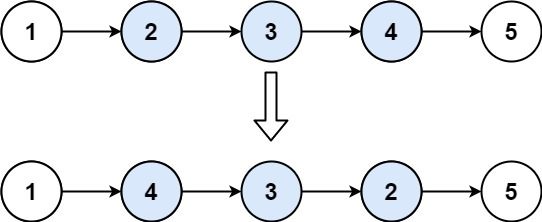Given the head of a singly linked list and two integers left and right where left <= right, reverse the nodes of the list from position left to position right, and return the reversed list.
Example 1:
Input: head = [1,2,3,4,5], left = 2, right = 4 Output: [1,4,3,2,5]
Example 2:
Input: head = [5], left = 1, right = 1 Output: [5]
Constraints:
- The number of nodes in the list is
n. 1 <= n <= 500-500 <= Node.val <= 5001 <= left <= right <= n
Follow up: Could you do it in one pass?
# Definition for singly-linked list.
# class ListNode:
# def __init__(self, val=0, next=None):
# self.val = val
# self.next = next
class Solution:
def reverseBetween(self, head: ListNode, left: int, right: int) -> ListNode:
if head is None or head.next is None or left == right:
return head
dummy = ListNode(0, head)
pre = dummy
for _ in range(left - 1):
pre = pre.next
p, q = pre, pre.next
cur = q
for _ in range(right - left + 1):
t = cur.next
cur.next = pre
pre, cur = cur, t
p.next = pre
q.next = cur
return dummy.next/**
* Definition for singly-linked list.
* public class ListNode {
* int val;
* ListNode next;
* ListNode() {}
* ListNode(int val) { this.val = val; }
* ListNode(int val, ListNode next) { this.val = val; this.next = next; }
* }
*/
class Solution {
public ListNode reverseBetween(ListNode head, int left, int right) {
if (head == null || head.next == null || left == right) {
return head;
}
ListNode dummy = new ListNode(0, head);
ListNode pre = dummy;
for (int i = 0; i < left - 1; ++i) {
pre = pre.next;
}
ListNode p = pre;
ListNode q = pre.next;
ListNode cur = q;
for (int i = 0; i < right - left + 1; ++i) {
ListNode t = cur.next;
cur.next = pre;
pre = cur;
cur = t;
}
p.next = pre;
q.next = cur;
return dummy.next;
}
}/**
* Definition for singly-linked list.
* function ListNode(val, next) {
* this.val = (val===undefined ? 0 : val)
* this.next = (next===undefined ? null : next)
* }
*/
/**
* @param {ListNode} head
* @param {number} left
* @param {number} right
* @return {ListNode}
*/
var reverseBetween = function(head, left, right) {
if (!head || !head.next || left == right) {
return head;
}
const dummy = new ListNode(0, head);
let pre = dummy;
for (let i = 0; i < left - 1; ++i) {
pre = pre.next;
}
const p = pre;
const q = pre.next;
let cur = q;
for (let i = 0; i < right - left + 1; ++i) {
const t = cur.next;
cur.next = pre;
pre = cur;
cur = t;
}
p.next = pre;
q.next = cur;
return dummy.next;
};/**
* Definition for singly-linked list.
* struct ListNode {
* int val;
* ListNode *next;
* ListNode() : val(0), next(nullptr) {}
* ListNode(int x) : val(x), next(nullptr) {}
* ListNode(int x, ListNode *next) : val(x), next(next) {}
* };
*/
class Solution {
public:
ListNode* reverseBetween(ListNode* head, int left, int right) {
if (head == nullptr || head->next == nullptr || left == right) {
return head;
}
ListNode *dummy = new ListNode(0, head);
ListNode *pre = dummy;
for (int i = 0; i < left - 1; ++i) {
pre = pre->next;
}
ListNode *p = pre, *q = pre->next;
ListNode *cur = q;
for (int i = 0; i < right - left + 1; ++i) {
ListNode *t = cur->next;
cur->next = pre;
pre = cur;
cur = t;
}
p->next = pre;
q->next = cur;
return dummy->next;
}
};/**
* Definition for singly-linked list.
* public class ListNode {
* public int val;
* public ListNode next;
* public ListNode(int val=0, ListNode next=null) {
* this.val = val;
* this.next = next;
* }
* }
*/
public class Solution {
public ListNode ReverseBetween(ListNode head, int left, int right) {
if (head == null || head.next == null || left == right)
{
return head;
}
ListNode dummy = new ListNode(0, head);
ListNode pre = dummy;
for (int i = 0; i < left - 1; ++i)
{
pre = pre.next;
}
ListNode p = pre;
ListNode q = pre.next;
ListNode cur = q;
for (int i = 0; i < right - left + 1; ++i)
{
ListNode t = cur.next;
cur.next = pre;
pre = cur;
cur = t;
}
p.next = pre;
q.next = cur;
return dummy.next;
}
}
